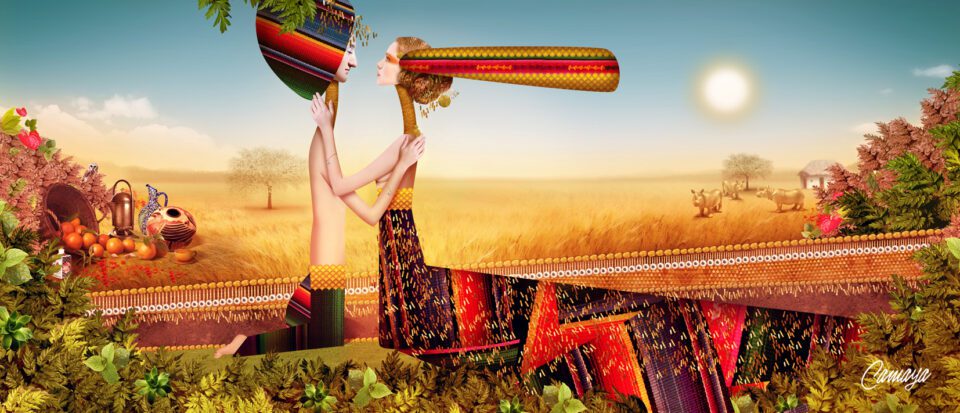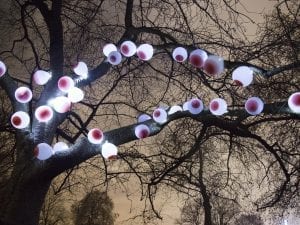Carolina Amaya is a visual artist from Colombia. She works with mixed media materials such as textiles, photography, oil and acrylic in the production of her works. She explores the subject of dreams as desires, intuition and other ways of life. She is inspired by the non-linear nature of dreams, lending her work an intensely visual, visceral quality, resulting in works inhabited by hybrid beings with plastic skin and dreamlike imaginary civilisations. She lectures about art at conferences and universities internationally, and teaches in Bogota.
A: You’ve previously explained that you are often inspired by your dreams. How do they transfer into visual art? Do you find it challenging to remember and recreate your dreams?
CA: When we are dreaming, the occipital part of our brain is activated; the amygdala, which is directly connected to our feelings of desire, fear, anguish and terror is activated and it all turns into a game with our unconscious. Our motor part is turned off and we ‘die’ physically but mentally our brains are as if we were awake. So my work is full of these essays of images and deep feelings. We are all made of dreams. These images are an analysis of my own life, of what I live and what I see every day. Desire, pleasure, eroticism… the primary feelings of the human being motivated me to recreate these images that occur at night as part of my own existence. Dreams, but at the same time a personal encounter or a personal psychoanalysis that I practice to find myself in another reality, which appears descriptively. I have been recording my dreams for 10 years, I also have techniques to remember dreams, which I practice unconsciously. Our dream desires are real representations of what we want as human beings.
A: The characters in your work The Last Garden are very striking. What is the story behind them?
CA: This is a series of four women leaders of civilisations that exist in my dreams. In the dream I saw my body separated into four women, but it was still the same. Each of these women represented their culture, the food they ate, their thoughts and their way of life. They also give us some ideas about the human condition: Last Red Garden 1 represents civilisation halves. All human beings are subjected to have half in life, when we share with another person our body. On the other hand this work represents the inequality of cultures, so within the same plane I present objects and cultural representations of both worlds, East and West. From my point of view we should all be equal. That’s why I use the two green apples that signify equality and knowledge. The second painting ass the questions, what are we made of? The other two leaders represent romantic aggression and the fact of wanting to leave the life that we live.
A: Your other projects include installation and sculpture pieces, do you enjoy working in other mediums? How do these help to develop your art?
CA: I like to explore video art and installation. Volume is one of my fascinations, I would like to invent a box that plays back dreams so that people remember them the next day and see them in pictures. I would also like to develop social projects such as making art for the blind, I want to create a tactile system to recreate the colours that work for both people who can see and for those that can not see.
A: Lightness vs Matter, your most recent work, focuses on the image of eyes. What message are you hoping to convey through these pieces?
CA: This composition of 15 paintings reveal an internal change that I experienced through a dream. Scientist Antti Revonsuo explained that dreams could be an anchor in our lives at the moment of sleeping, because if we do not sleep as humans we do not exist. He adds that nightmares can be predictive, they can teach us to correct our mistakes and to stay alert to what happens. Eyes specifically reflect the need for internal observation I have, because everything I observe is a form of taking control in my life. Eyes are life, watching everything that happens. Each of these paintings reflects the direct relationship between the lightness of the material of the objects: the inverse relationship between something heavy and something light, and how even the heaviest can be lighter depending on how you look at it.
Learn more about Carolina Amaya at www.carolinaamaya.com.
To see her listing in the Artists’ Directory in Issue 69 of Aesthetica Magazine, pick up a copy at www.aestheticamagazine.com.
Follow us on Twitter @AestheticaMag for the latest news in contemporary art and culture.
Credits:
1. Carolina Amaya, Cherry Tree 1, 2014. Courtesy of the artist.
2. Carolina Amaya, Eyes Many Eyes. Courtesy of the artist.





